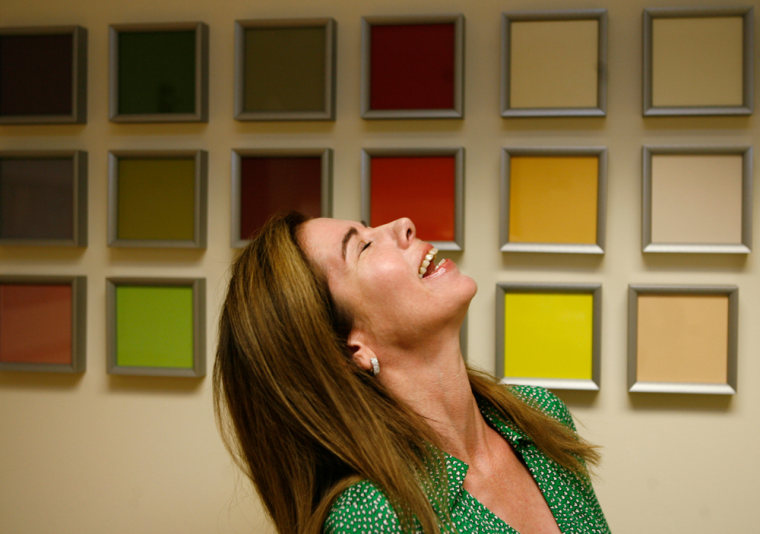You will find it aesthetically pleasing when blue is paired with silver and gray. You will feel that blues paired with browns are played out. You just don’t know it yet.
So say the color prognosticators at the Color Marketing Group, based in Alexandria. The 1,000-member industry association group has for decades sought to forecast color trends years in advance, giving its members a better chance to get their production schedules in sync with consumer tastes. Its members include representatives from General Motors, Kimberly-Clark — which puts a lot of thought into the color schemes for its Kleenex boxes — and independent designers who do work for consumer giants like Procter & Gamble.
A similar group, the Color Association of the United States, based in New York, has been forecasting color trends since 1915.
Forecasting color trends is serious business, the trade groups say. For one, it’s important that various industries can coordinate, so the offerings from a paint manufacturer don’t clash with those produced by furniture makers, for example. In addition, designers cite multiple studies that show color selection is playing an increasing role in consumer purchases.
“It’s a more sophisticated, design-aware consumer today,” said Christopher Webb, color trend designer for GM North America. Webb said 40 percent of consumers will walk out of a dealership and choose a different brand if the color choices aren’t acceptable.
Doty Horn, a CMG member and director of color and design for Benjamin Moore Paints, said the ubiquity of home makeover shows on TV has increased awareness among consumers about their remodeling options and color choices.
The groups claim strong a track record, though they admit to a certain extent that their forecasts can become something of a self-fulfilling prophecy. Still, they are sensitive to the notion of a secretive color cabal dictating color selections to the masses.
Color Marketing Group’s president, Jack Bredenfoerder said the forecasts pick up on recognizable trends that would advance regardless of whether Color Marketing Group had identified them.
Christine Chow, the color association’s membership director, said the trend forecasts have to make sense to the designers, or they wouldn’t rely on them.
“They don’t have to do what we suggest unless it makes sense to them,” Chow said. “And we’re not sitting in our offices tossing at dart boards” to make our predictions.
On a recent window shopping trip in Tysons Corner, consumer Celia Coughlin of Fairfax said you can’t help but notice the color trends as they come and go from the marketplace, but she is generally not swayed.
“I look at what would fit with what’s already in my home” rather than hopping on the latest color trend, she said.
Still, she said she can use the cycles to her advantage — particularly in fashion, where colors change more frequently.
“I know I can get what I want a few months down the road” in clearance and overstock sales once retailers swap out one color for another, she said.
Interestingly, the two groups tend to forecast similar trends, even though their methodologies are very different. The Color Marketing Group holds semiannual conferences with hundreds of members who meet in secret and develop a consensus on long-range trends. The Color Association relies on small, hand-picked committees of eight to 12 experts.
But both groups predict a continued dominance of blues in the next year or so, with a surge in metallic colors like silver and gold displacing the some of the browns.
Jaime Stephens, director of the Color Marketing Group, said societal and economic trends influence color trends. Several years ago, Stephens said the group predicted that increased awareness of environmental interest would spark a resurgence in greens — a trend that continues to play out.
Bredenfoerder said the Beijing Olympics next year could spark a trend in reds and yellows, traditional Chinese colors. Globalization and the increasing influence of countries like China and India also play a role. Bredenfoerder said the traditional spice colors associated with India have been in vogue, and with that has come a revival of teal, a blue shade which complements them.
Even politics can play a role. Bredenfoerder said he expects in 2009 that the inauguration of a new president to replace George Bush will lead to a more optimistic outlook, and will help push colors to brighter hues.
Chow offered a slightly different take: the nation’s resurgent interest in politics will reinforce trends toward reds and blues, serious colors that are naturally associated with politics.
At General Motors, Webb said the company used to copy the color trends in the fashion world but now takes a more sophisticated approach that allows it to get ahead of trends — particularly important for a production schedule that requires decisions to be made years in advance.
It also takes a more conservative approach, looking at families of colors. If purple, for instance, is increasing in popularity, Webb looks at shades of red and blue that might capitalize on the trend in a more accessible way.
“People are inevitably a bit more conservative” when selecting a car color, Webb said. “The size and proportion of a car or truck changes people’s perceptions of a particular color.”
At Benjamin Moore, Horn said the company spends a lot of time tracking colors in the fashion world.
“What you wear often ends up on your wall,” she said. “The colors in your closet or in your makeup box invariably will be colors chosen to end up in your home.”
Certain colors invariably make comebacks in different incarnations. A new name and a slight change of shade, or pairing a color with different combinations can make a big difference.
“If you call it ’avocado,’ you can’t sell it,” Horn said, referring to the ubiquitous green appliance shade of the 60s and 70s. “If you call it ’sage,’ it might sell.”
